Religion In Serbia
Serbia has been traditionally a Christian country since the Christianization of Serbs by Clement of Ohrid and Saint Naum in the 9th century.
The dominant confession is Eastern Orthodoxy in the fold of Serbian Orthodox Church.
Religion in Serbia (2022 census)
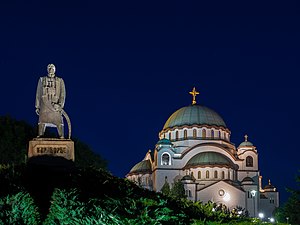
During the Ottoman rule of the Balkans, Sunni Islam established itself in the territories of Serbia, mainly in southern regions of Raška and Preševo Valley, as well as in what is today the disputed territory of Kosovo and Metohija. The Catholic Church has roots in the country since the presence of Hungarians in Vojvodina (mainly in the northern part of the province), while Protestantism arrived in the 18th and 19th centuries with the settlement of Slovaks in Vojvodina.
Demographics

| 1921 | 1953 | 1991 | 2002 | 2011 | 2022 | |||||||
|---|---|---|---|---|---|---|---|---|---|---|---|---|
| Number | % | Number | % | Number | % | Number | % | Number | % | Number | % | |
| Eastern Orthodox | 3,321,090 | 75.9 | 4,422,330 | 71.7 | 6,347,026 | 81.8 | 6,371,584 | 85.0 | 6,079,395 | 84.6 | 5,387,426 | 81.1 |
| Catholic | 751,429 | 17.16 | 607,612 | 9.85 | 496,226 | 6.4 | 410,976 | 5.48 | 356,957 | 4.97 | 257,269 | 3.87 |
| Protestant | no data | no data | 111,556 | 1.81 | 86,894 | 1.12 | 78,646 | 1.05 | 71,284 | 0.99 | 54,678 | 0.82 |
| Other Christian | 33,257 | 0.54 | 1,381 | 0.02 | 2,191 | 0.03 | 3,211 | 0.04 | 59,346 | 0.89 | ||
| "Christian" | 12,882 | 0.17 | 45,083 | 0.63 | ||||||||
| Muslim | 97,672 | 2.23 | 155,657 | 2.52 | 224,120 | 2.89 | 239,658 | 3.2 | 222,829 | 3.1 | 278,212 | 4.19 |
| Jewish | 26,464 | 0.6 | 108,303 | 0.02 | 740 | 0.01 | 785 | 0.01 | 578 | 0.01 | 602 | 0.01 |
| Eastern religions | no data | no data | no data | no data | no data | no data | 240 | 0.00 | 1,237 | 0.02 | 1,207 | 0.02 |
| Irreligious / Atheist | no data | no data | 826,954 | 13.4 | 159,642 | 2.06 | 40,068 | 0.53 | 80,053 | 1.11 | 74,139 | 1.12 |
| Agnostic | 4,010 | 0.06 | 8,654 | 0.13 | ||||||||
| Declined to answer | 197,031 | 2.63 | 220,735 | 3.07 | 169,486 | 2.55 | ||||||
| Other | 181,940 | 4.16 | 1,796 | 0.03 | 13,982 | 0.18 | 6,649 | 0.09 | 1,776 | 0.02 | 500 | 0.01 |
| Unknown | 10,768 | 0.17 | 429,560 | 5.54 | 137,291 | 1.83 | 99,714 | 1.39 | 355,484 | 5.35 | ||
| Total | 4,378,595 | 100 | 6,171,013 | 100 | 7,759,571 | 100 | 7,498,001 | 100 | 7,186,862 | 100 | 6,647,003 | 100 |
Christianity
Eastern Orthodoxy

Most Serbians are adherents of the Serbian Orthodox Church, while the Romanian Orthodox Church is also present in parts of Vojvodina inhabited by an ethnic Romanian minority. Besides Serbs, other Eastern Orthodox Christians include Montenegrins, Romanians and Vlachs, Macedonians, Bulgarians, and majority of Roma.

Eastern Orthodox Christianity predominates throughout most of Serbia. It is less prevalent in several municipalities and cities near borders with neighboring countries, where adherents of Islam or Catholicism are more numerous, and two predominantly Protestant municipalities in Vojvodina. Eastern Orthodoxy also predominates in most of Serbia's large cities, except for Subotica (mostly Catholic) and Novi Pazar (mostly Muslim).
The identity of ethnic Serbs was historically largely based on Eastern Orthodox Christianity and on the Serbian Orthodox Church, to the extent that there are claims[by whom?] that those not among its faithful are not Serbs. However, the conversion of the south Slavs from paganism to Christianity took place before the Great Schism, the split between the Greek East and the Latin West. After the Schism, generally speaking, those Christians who lived within the Eastern Orthodox sphere of influence became "Eastern Orthodox" and those who lived within the Catholic sphere of influence, under Rome as the patriarchal see of the West, became "Catholic". Some ethnologists consider that the distinct Serb and Croat identities relate to religion rather than ethnicity. Since the second half of the 19th century, some Serbs have converted to Protestantism, while historically some Serbs also were Latin Catholic (especially in Dalmatia) or Eastern Catholic.
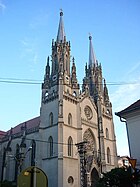
Catholicism
Catholicism is present mostly in the northern part of Vojvodina, notably in the municipalities with a Hungarian ethnic majority (Bačka Topola, Mali Iđoš, Kanjiža, Senta, Ada, Čoka), the multi-ethnic city of Subotica, and the multi-ethnic municipality of Bečej. It is represented mainly by the following ethnic groups: Hungarians, Croats, Bunjevci, Germans, Slovenes, Czechs, etc. A smaller number of Roma people, Slovaks and Serbs are also Catholic. The ethnic Rusyns and a smaller part of the ethnic Ukrainians are primarily Eastern Rite Catholics.
Protestantism
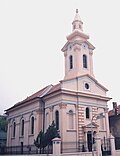
The largest percentage of Protestant Christians in Serbia on the municipal level is in the municipalities of Bački Petrovac and Kovačica, where an absolute or relative majority of the population are ethnic Slovaks (most of whom are adherents of Protestant Christianity). Some members of other ethnic groups (especially Serbs in absolute terms and Hungarians and Germans in proportional terms) are also adherents of various forms of Protestant Christianity.
There are various Protestant groups in the country, including Methodists, Seventh-day Adventists, and Evangelical Baptists (Nazarene). Many of these groups are situated in the culturally diverse province of Vojvodina. Protestantism (mostly in its Nazarene form) started to spread among Serbs in Vojvodina in the last decades of the 19th century. Before World War II, the number of Protestants in the region was larger.
According to the 2011 census, the largest Protestant communities were recorded in the municipalities of Kovačica (11,349) and Bački Petrovac (8,516), as well as in Stara Pazova (4,940) and the second largest Serbian city Novi Sad (8,499), which are predominantly Eastern Orthodox. While Protestants from Kovačica, Bački Petrovac, and Stara Pazova are mostly Slovaks and members of the Slovak Evangelical Church of the Augsburg Confession in Serbia, services in most of the Protestant churches in Novi Sad are performed in Serbian.
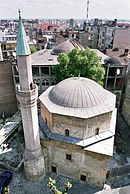
Islam
With the arrival of the Ottoman Empire, some Serbs converted to Islam. This was particularly, but not wholly, so in Ottoman Bosnia. The best known Muslim Serb is probably either Mehmed Paša Sokolović or Meša Selimović.
Today, Islam is mostly present in southwest Serbia, in the regions of Sandžak and Raška (notably in the city of Novi Pazar and municipalities of Tutin and Sjenica), as well as in parts of southern Serbia (municipalities of Preševo and Bujanovac). Ethnic groups whose members are mostly adherents of Islam are: Bosniaks, ethnic Muslims, Albanians, and Gorani. A significant number of Roma people are also adherents of Islam. Predominantly Muslim Albanians who boycotted the census in 2011 decided to participate in 2022 census.
Adherents belong to one of two communities – Islamic Community of Serbia or the Islamic Community in Serbia.
Judaism

As of 2011, out of 787 declared Jews in Serbia, 578 stated their religion as Judaism, mostly in the cities of Belgrade (286), Novi Sad (84), Subotica (75) and Pančevo (31). The only remaining functioning synagogue in Serbia is the Belgrade Synagogue. There are also small numbers of Jews in Zrenjanin and Sombor, with isolated families scattered throughout the rest of Serbia.
Irreligion
About 1.1% of the Serbian population is atheist. Religiosity was lowest in Novi Beograd, with 3.5% of population being atheists (compare to whole of Belgrade's and Novi Sad's 1.5%) and highest in rural parts of the country, where atheism in most municipalities went below 0.01%.
In a 2009 Gallup poll, 44% of respondents in Serbia answered 'no' to the question "Is religion an important part of your daily life?"
A Pew Research Center poll conducted from June 2015 to July 2016 found that 2% of Serbia were atheists, while 10% stated that they "Do not believe in God".
Role of religion in public life
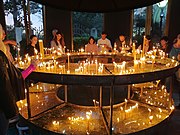
Public schools allow religious teaching in cooperation with religious communities having agreements with the state, but attendance is not mandated. Religion classes (Serbian: verska nastava) are organized in public elementary and secondary schools, most commonly coordinated with the Serbian Orthodox Church, but also with the Catholic Church and Islamic community.
Public holidays in Serbia also include the religious festivals of Eastern Orthodox Christmas and Easter. Saint Sava Day is a working holiday celebrated as a Day of Spirituality as well as Day of Education. Believers of other faiths are legally allowed to celebrate their religious holidays.
Religious freedom
The government of Serbia does not keep records of religiously motivated violence. However reports from religious leaders in 2022 noted that incidents have gone down, and Jewish leaders reported no incidents at all in that year.
The laws of Serbia establish freedom of religion, forbid the establishment of a state religion, and outlaw religious discrimination. While registration with the government is not necessary for religious groups to practice, the government confers certain privileges to registered groups. The government maintains a two-tiered system of registered groups, split between "traditional" groups and "nontraditional" groups. Minority groups and independent observers have complained that this system comprises religious discrimination, especially as the media regularly names nontraditional groups as 'sects'.
The media and individual members of the National Assembly have been criticized for using disparaging language when referring to nontraditional groups. Antisemitic literature is commonly available in bookstores, and is prevalent online.
Although religious freedom was largely respected by the government of the Kingdom of Yugoslavia and Serbia's constitutions through its various incarnations as either an independent state or as part of Yugoslavia have nominally upheld religious freedom, it was also the site of significant religiously and ethnically-motivated war crimes during World War II and the Yugoslav Wars. The government has programs established for the restitution of property confiscated by the government of Yugoslavia after World War II, and for property lost in the Holocaust.
In 2023, Freedom House rated Serbia 4 out of 4 on the question "Are individuals free to practice and express their religious faith or nonbelief in public and private?".
See also
References
Sources
- Kuburić, Z., 2010. Verske zajednice u Srbiji i verska distanca. CEIR—Centar za empirijska istraživanja religije.
- Radić, Radmila (2007). "Serbian Christianity". The Blackwell Companion to Eastern Christianity. Malden, MA: Blackwell Publishing. pp. 231–248. ISBN 9780470766392.
- Radisavljević-Ćiparizović, D., 2002. Religija i svakodnevni život: vezanost ljudi za religiju i crkvu u Srbiji krajem devedesetih. Srbija krajem milenijuma: Razaranje društva, promene i svakodnevni život.
- Radulović, L.B., 2012. Religija ovde i sada: revitalizacije religije u Srbiji. Srpski geneaološki centar, Odeljenje za etnologiju i antropologiju Filozofskog fakulteta.
- Blagojević, M., 2011. „Aktuelna religioznost građana Srbije “, u A. Mladenović (prir.). Religioznost u Srbiji 2010, pp. 43–72.
- Đorđević, D.B., 2005. Religije i veroispovesti nacionalnih manjina u Srbiji. Sociologija, 47(3), pp. 193–212.
- Đukić, V., 2008. Religije Srbije–mreža dijaloga i saradnje.
- Ilić, A., 2013. Odnos religije i društva u današnjoj Srbiji. Religija i Tolerancija, 1(3).
- Kuburić, Z. and Gavrilović, D., 2013. Verovanje i pripadanje u savremenoj Srbiji. Religija i Tolerancija, (1).
External links

This article uses material from the Wikipedia English article Religion in Serbia, which is released under the Creative Commons Attribution-ShareAlike 3.0 license ("CC BY-SA 3.0"); additional terms may apply (view authors). Content is available under CC BY-SA 4.0 unless otherwise noted. Images, videos and audio are available under their respective licenses.
®Wikipedia is a registered trademark of the Wiki Foundation, Inc. Wiki English (DUHOCTRUNGQUOC.VN) is an independent company and has no affiliation with Wiki Foundation.